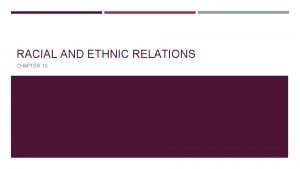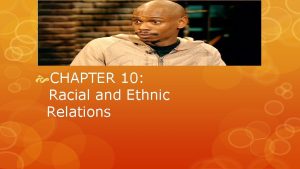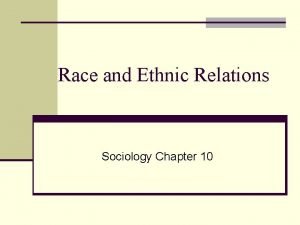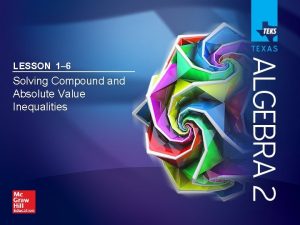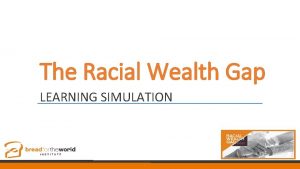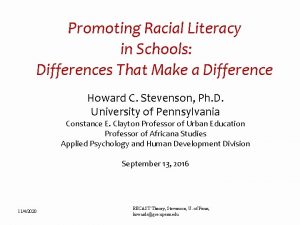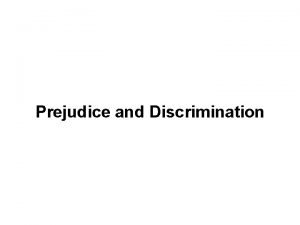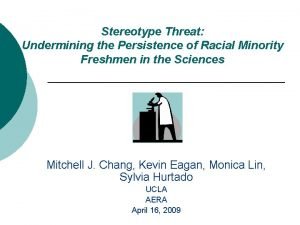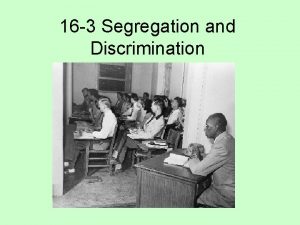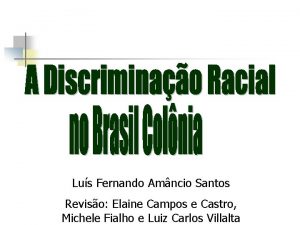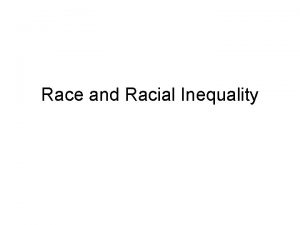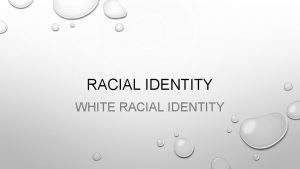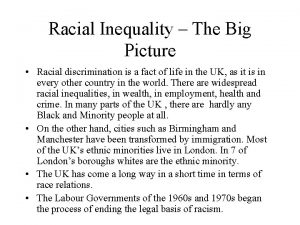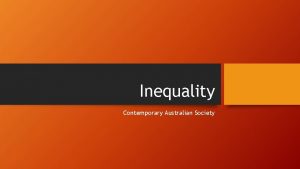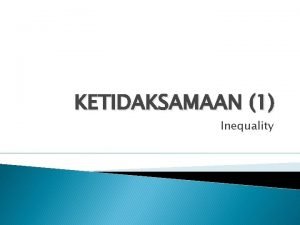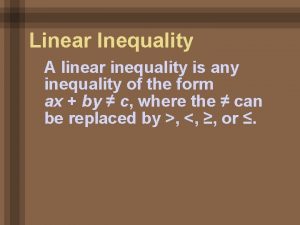Chapter 11 Racial Inequality In Conflict and Order















- Slides: 15

Chapter 11 Racial Inequality In Conflict and Order: Understanding Society, 11 th edition This multimedia product and its contents are protected under copyright law. The following are prohibited by law: any public performance or display, including transmission of any image over a network; preparation of any derivative work, including the extraction, in whole or in part, of any images; any rental, lease, or lending of the program.

Racial and Ethnic Minorities • The most important characteristic of a minority group is that it is dominated by a more powerful group (majority group). – The terms majority and minority describe power differences. • The concept of race is a social invention. – It is not biologically significant. – Racial groups are set apart and singled out for unequal treatment.

Racial Categories • Racial formation – Society is continually creating and transforming racial categories • The U. S. Census Bureau measures race on the basis of self-identification. – In 2000 people were allowed to record themselves in 2 or more racial categories. – Of the U. S. population 2. 4% identified themselves as multiracial.

Racial Categories • Ethnicity is a social category that allows for a broader range of affiliation. – Ethnic groups are distinctive on the basis of national origin, language, religion, and culture. • Racial ethnic group refers to groups that are socially subordinated and remain culturally distinct within U. S. society. – It includes the systematic discrimination of socially constructed racial groups and their distinctive cultural arrangements. Copyright © Allyn and Bacon 2007

Differences among Racial and Ethnic Groups African Americans Latinos Asian Americans Native Americans Copyright © Allyn and Bacon 2007

Explanations of Racial and Ethnic Inequality • Deficiency theories view minority-group members as unequal because they lack some important feature common among the majority. – These deficiencies may be biological or cultural (such as culture of poverty). Copyright © Allyn and Bacon 2007

Explanations of Racial and Ethnic Inequality • Bias theories place the blame for inequality on the prejudiced attitudes of the dominant group. – These theories however, do not explain the discriminatory acts of the unprejudiced, which are aimed at preserving privilege. • Structural discrimination theories argue that inequality is the result of external constraints as opposed to internal cultural factors. Copyright © Allyn and Bacon 2007

Explanations of Racial and Ethnic Inequality • Four main features of institutional discrimination – Forces of history shape present conditions – Discrimination can occur without conscious bigotry – Institutional discrimination is less visible than are individual acts of discrimination – Discrimination is reinforced by the interrelationships among the institutions of society Copyright © Allyn and Bacon 2007

Figure 11. 2 – Percent of the Population, by Race and Hispanic Origin: 1990, 2000, 2025, and 2050 (Middle-Series Projection) Source: U. S. Bureau of the Census, 1997. “Population Profile of the United States: 1997, ” Current Population Reports, Series P 23 -194. Washington, DC: U. S. Government Printing Office, p. 9. Copyright © Allyn and Bacon 2007

Racial Stratification from the Order and Conflict Perspectives • Order Perspective – Order theorists accent patterns of inclusion, orderly integration, and the assimilation of racial groups. – Order theorists are concerned with how minorities adapt to the core society. Copyright © Allyn and Bacon 2007

Racial Stratification from the Order and Conflict Perspectives • Conflict Perspective – Conflict theories are critical of assimilation theories for ignoring social conditions that exclude racial minorities from full participation in U. S. society. – Racial stratification exists because certain segments of society benefit from it. – Racial ethnics are located in the larger society in ways that prevent their assimilation. Copyright © Allyn and Bacon 2007

Discrimination Against Blacks and Hispanics: Continuity and Change • Civil rights legislation improved the status of some racial-ethnics, yet the overall position of Blacks and Latinos relative to Whites has not improved. • Large gaps remain in work, earnings and education. • Global and economic transformations have contributed to the persistent poverty in U. S. centers. Copyright © Allyn and Bacon 2007

Figure 11. 4 – Homeownership Rates by Race and Ethnicity of Householder, 1994 -2003 Sources: Betsy Leondar-Wright, Meizhu Lui, Gloribell Mota, Dedrick Muhammad, and Mara Voukdis, 2005, State of the Dream 2005: Disowned in the Ownership Society. Boston: United for a Fair Economy, p. 11. www. faireconomy. com. Reprinted by permission. Copyright © Allyn and Bacon 2007

Figure 11. 5 – Family Poverty Rates by Race, 1988 -2003 Sources: Betsy Leondar-Wright, Meizhu Lui, Gloribell Mota, Dedrick Muhammad, and Mara Voukdis, 2005, State of the Dream 2005: Disowned in the Ownership Society. Boston: United for a Fair Economy, p. 10. www. faireconomy. com. Reprinted by permission. Copyright © Allyn and Bacon 2007

Contemporary Trends and Issues in U. S. Racial and Ethnic Relations • Growing Racial Strife • More Racially Based Groups • Native Americans Hit Hard by Violent Crime • Profiling and Maltreatment • Campus Racial Tension • Economic Polarization in U. S. Inner Cities • Racial Policies in the New Century Copyright © Allyn and Bacon 2007
 Timid bigot example
Timid bigot example Chapter 10 racial and ethnic relations
Chapter 10 racial and ethnic relations Chapter 10 racial and ethnic relations review worksheet
Chapter 10 racial and ethnic relations review worksheet 1-6 solving compound and absolute value inequalities
1-6 solving compound and absolute value inequalities Via optica
Via optica Black studies and the racial mountain
Black studies and the racial mountain Jim crow laws in what region or regions did it exist
Jim crow laws in what region or regions did it exist Racial wealth gap simulation
Racial wealth gap simulation Promoting racial literacy in schools
Promoting racial literacy in schools William jennings bryan apush
William jennings bryan apush Racial prejudice
Racial prejudice Don tiburcio symbolism in noli me tangere
Don tiburcio symbolism in noli me tangere Racial insults
Racial insults In what region did racial etiquette exist
In what region did racial etiquette exist Cartel ley organica contra la discriminacion racial
Cartel ley organica contra la discriminacion racial Democracia racial
Democracia racial
